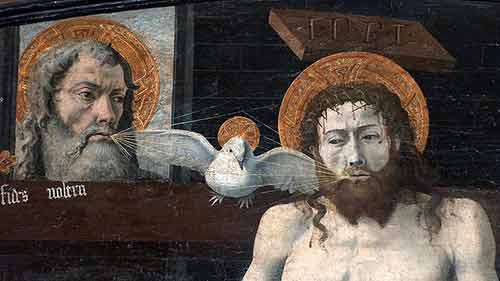
Filioque
The “Nicene-Constantinopolitan Creed” (normally referred to as the “Nicene” Creed) has
Καὶ εἰς τὸ Πνεῦμα τὸ Ἅγιον, τὸ κύριον, τὸ ζῳοποιόν, τὸ ἐκ τοῦ Πατρὸς ἐκπορευόμενον
(And in the Holy Spirit, the Lord, the giver of life, from the Father proceeding)
But the Latin text used in the Western Church has the Holy Spirit proceeding “from the Father and the Son“.
Et in Spiritum Sanctum, Dominum, et vivificantem: qui ex Patre Filioque procedit
(And in the Holy Spirit, the Lord, and giver of life, who from the Father and the Son proceeds)
This (Filioque) is one of the great divisions between Eastern and Western Christianity, Eastern Christianity maintaining the text as received from an ecumenical council.
The inner relationship between the Persons of the Trinity is not dealt with in the New Testament- whatever biblical cherry-picking individuals may engage in. “Filioque” was inserted into the creed at the Council of Toledo (587) as part of a battle against Arianism*. That was a local rather than ecumenical council. There may have been no thought of altering the officially held creed, but the insertion spread in the West.
UPDATE 16 November 2013: From Wikipedia:
It is commonly stated that the phrase Filioque first appeared as inserted into the Creed, as an anti-Arian addition,[76][77][78] at the Third Council of Toledo(589), at which Visigothic Spain renounced Arianism, accepting Catholic Christianity. However, the acts of the council, while decreeing that “Spiritusque sanctus confitendus a nobis, et praedicandus est a patre et filio procedere” (the Holy Spirit is to be professed and preached by us as proceeding from the Father and the Son), records faithfully, without the addition of Filioque, the Creed of the First Council of Nicaea and that of the First Council of Constantinople.[79] The first documented appearance of the phrase as included in the Creed is at the 12th Council of Toledo (681).[80]
The issue of the Filioque will be continued in another post.
*****
This is the twenty-second post in a series on the Creed.
The first is Apostles’ Creed.
The second is I believe in God.
The third is a source of the Apostles’ Creed.
The fourth is I believe in the Father.
The fifth is Handing over the Creed.
The sixth is I believe in Jesus Christ, God’s only Son
The seventh is Don’t use the creed in worship
They eighth is Truly God truly human
The ninth is Conceived by the Holy Spirit
The tenth is Don’t use the creed in worship (part 2)
The eleventh is Born of the Virgin Mary
The twelfth is Don’t use the creed in worship (part 3)
The thirteenth is Crucified under Pontius Pilate
The fourteenth is crucified
The fifteenth is Holy Saturday
This sixteenth is He descended to the dead
The seventeenth is on the third day he rose again
The eighteenth is Seated at the right hand of the Father
The nineteenth is Judge the living and the dead
The twentieth is I believe in the Holy Spirit
The twenty-first is But Wait, There’s More!



John 15 26
There is something curiously unsettling about that picture, especially Jesus’s expression.